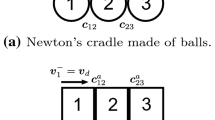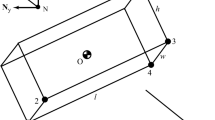Abstract
Formulating a consistent theory for rigid-body dynamics with impacts is an intricate problem. Twenty years ago Stewart published the first consistent theory with purely inelastic impacts and an impulsive friction model analogous to Coulomb friction. In this paper we demonstrate that the consistent impact model can exhibit multiple solutions with a varying degree of dissipation even in the single-contact case. Replacing the impulsive friction model based on Coulomb friction by a model based on the maximum dissipation principle resolves the non-uniqueness in the single-contact impact problem. The paper constructs the alternative impact model and presents integral equations describing rigid-body dynamics with a non-impulsive and non-compliant contact model and an associated purely inelastic impact model maximizing dissipation. An analytic solution is derived for the single-contact impact problem. The models are then embedded into a time-stepping scheme. The macroscopic behaviour is compared to Coulomb friction in a large-scale granular flow problem.










Similar content being viewed by others
References
Anitescu M, Potra F (1997) Formulating dynamic multi-rigid-body contact problems with friction as solvable linear complementarity problems. Nonlinear Dyn 14(3):231–247
Bannerman MN, Sargant R, Lue L (2011) DynamO: a free O(N) general event-driven molecular dynamics simulator. J Comput Chem 32(15):3329–3338
Bonnefon O, Daviet G (2011) Quartic formulation of coulomb 3D frictional contact. Technical report RT-0400. INRIA
Diebel J (2006) representing attitude: Euler angles, unit quaternions, and rotation vectors. Matrix 58:1–35
Erleben K (2004) Stable, robust, and versatile multibody dynamics animation. PhD thesis. University of Copenhagen
Gavrea BI, Anitescu M, Potra FA (2008) Convergence of a class of semi-implicit timestepping schemes for nonsmooth rigid multibody dynamics. SIAM J Optim 19(2):969–1001
Hassanpour A et al (2011) Analysis of particle motion in a paddle mixer using discrete element method (DEM). Powder Technol 206(1):189–194
Jayasundara C et al (2011) CFD-DEM modelling of particle flow in IsaMills–Comparison between simulations and PEPT measurements. Miner Eng 24(3):181–187
Jean M (1999) The non-smooth contact dynamics method. Comput Methods Appl Mech Eng 177(3):235–257
Jia Y-B (2013) Three-dimensional impact: energybased modeling of tangential compliance. Int J Robot Res 32(1):56–83
Jia Y-B, Wang F (2016) Analysis and computation of two body impact in three dimensions. J Comput Nonlinear Dyn 12:041012
Lubliner J (1984) A maximum-dissipation principle in generalized plasticity. Acta Mech 52(3):225–237
Mirtich B (1996) Impulse-based dynamic simulation of rigid body systems. PhD thesis. University of California
Mirtich B, Canny J (1995) Impulse-based simulation of rigid bodies. In: Proceedings of the 1995 symposium on interactive 3D graphics. ACM, pp 181–ff
Mishra B, Rajamani R (1992) The discrete element method for the simulation of ball mills. Appl Math Model 16(11):598–604
Mitarai N, Nakanishi H (2012) Granular flow: dry and wet. Eur Phys J Spec Topic 204(1):5–17
Moreau JJ (1988) Unilateral contact and dry friction in finite freedom dynamics. In: Moreau JJ, Panagiotopoulos PD (eds) Nonsmooth mechanics and applications. Springer, New York, pp 1–82
Nuseirat AA-F, Stavroulakis G (2000) A complementarity problem formulation of the frictional grasping problem. Comput Methods Appl Mech Eng 190:941–952
Painlevé P (1895) Sur les lois du frottement de glissement. C R Acad Sci Paris 121:112–115
Popa C, Preclik T, Rüde U (2015) Regularized solution of LCP problems with application to rigid body dynamics. Numer Algorithms 69(1):145–156
Preclik T (2014) Models and algorithms for ultrascale simulations of non-smooth granular dynamics. PhD thesis. Friedrich-Alexander-Universität Erlangen-Nürnberg
Preclik T, Rüde U (2015) Ultrascale simulations of non-smooth granular dynamics. Comput Part Mech 2(2):173–196
Sauer J, Schömer E (1998) A constraint-based approach to rigid body dynamics for virtual reality applications. In: Proceedings of the ACM symposium on virtual reality software and technology, pp 153–162
Shen Y, Stronge W (2011) Painlevé paradox during oblique impact with friction. Eur J Mech A/Solids 30(4):457–467
Stewart DE (1998) Convergence of a time-stepping scheme for rigid-body dynamics and resolution of Painlevé’s problem. Arch Ration Mech Anal 145(3):215–260
Stewart DE (2011) Dynamics with inequalities: impacts and hard constraints. SIAM, Philadelphia
Stewart D (2000) Rigid-body dynamics with friction and impact. SIAM Rev 42(1):3–39
Stewart D, Trinkle J (1996) An implicit timestepping scheme for rigid body dynamics with inelastic collisions and coulomb friction. Int J Numer Methods Eng 39(15):2673–2691
Stronge WJ (1990 ) Rigid body collisions with friction. In: Proceedings of the royal society of London A: mathematical, physical and engineering sciences, vol. 431, no. 1881. The Royal Society, pp 169–181
Stronge WJ (2004) Impact mechanics. Cambridge University Press, Cambridge
Tasora A, Anitescu M (2010) A convex complementarity approach for simulating large granular flows. J Comput Nonlinear Dyn 5(3):1–10
Tasora A, Anitescu M (2011) A matrix-free cone complementarity approach for solving large-scale, nonsmooth, rigid body dynamics. Comput Methods Appl Mech Eng 200(5):439–453
Acknowledgements
The authors would like to acknowledge the support through the Cluster of Excellence Engineering of Advanced Materials (EAM).
Author information
Authors and Affiliations
Corresponding author
Appendix
Appendix

Rights and permissions
About this article
Cite this article
Preclik, T., Eibl, S. & Rüde, U. The maximum dissipation principle in rigid-body dynamics with inelastic impacts. Comput Mech 62, 81–96 (2018). https://doi.org/10.1007/s00466-017-1486-0
Received:
Accepted:
Published:
Issue Date:
DOI: https://doi.org/10.1007/s00466-017-1486-0




